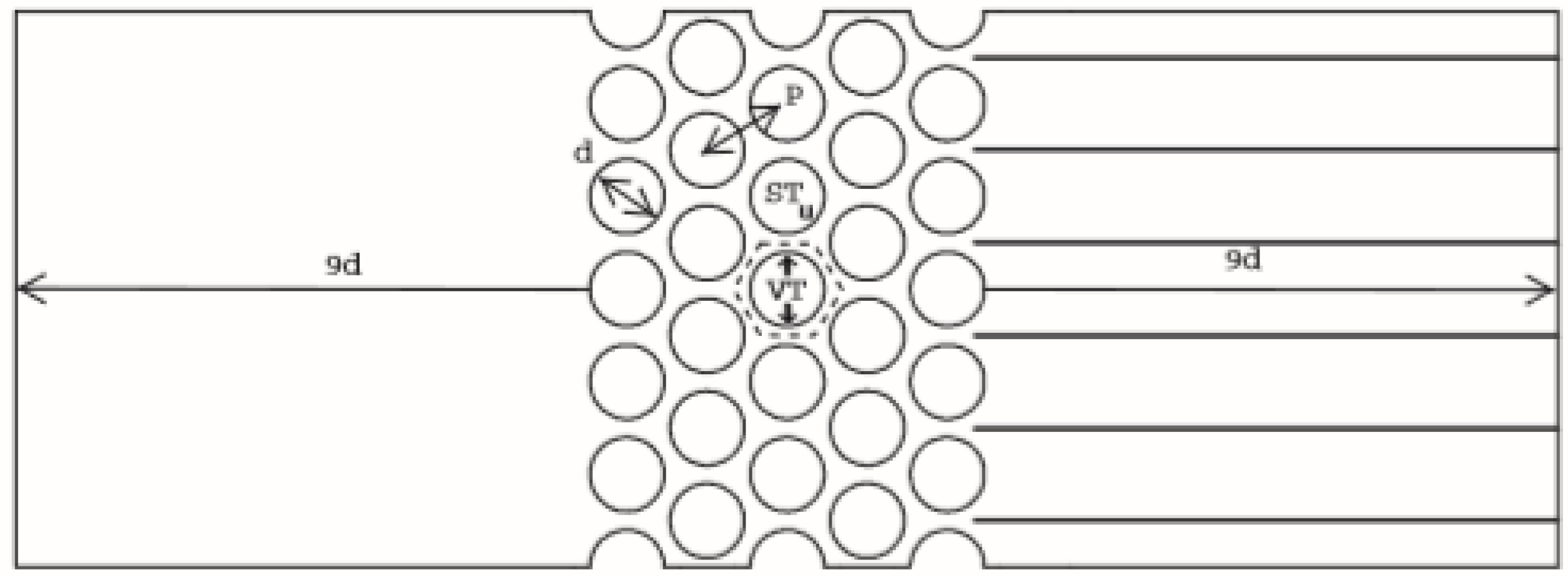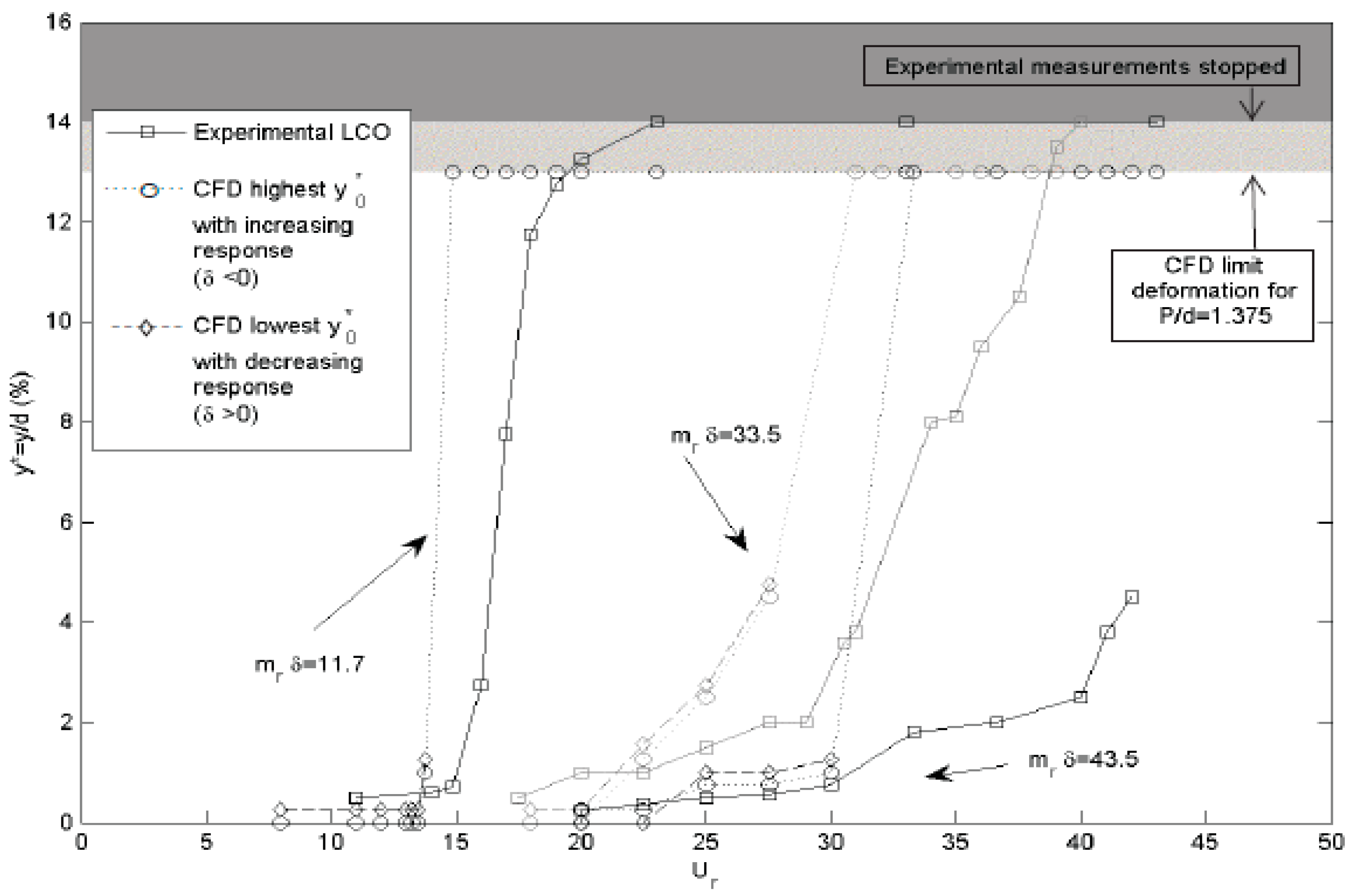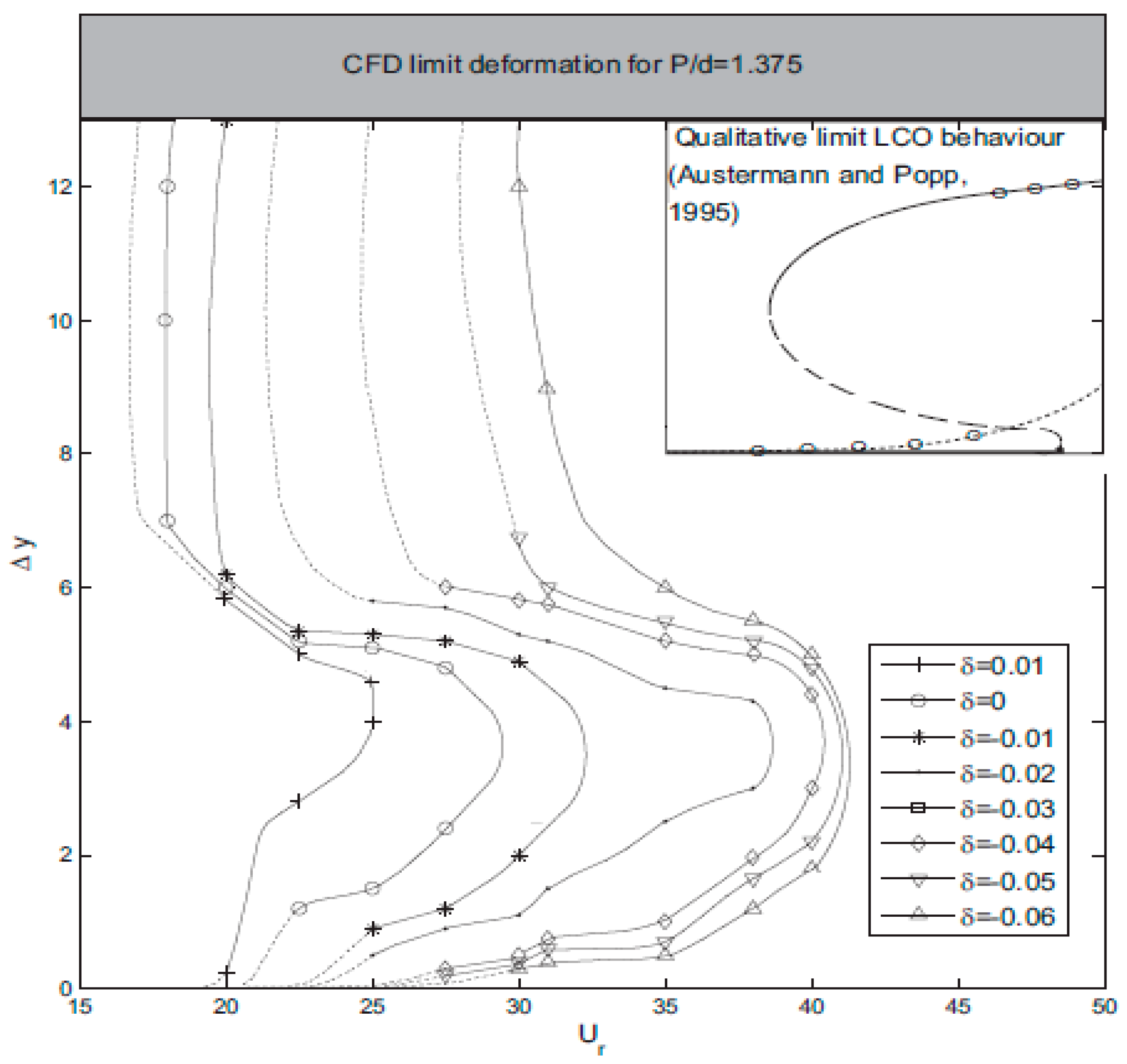A Computational Study on the Damping-Amplitude Dependence and Estimation of the Limit Cycle Oscillations for Normal Triangular Arrays with One Tube Undergoing Fluidelastic Instability †
Abstract
:1. Introduction
2. Numerical Domain and Mesh
3. CFD Methodology for LCO Determination
4. Results
5. Conclusions
- The methodology lightly under predict LCO in the stable regime while in unstable regime (for high amplitudes) the CFD overpredicts the real amplitude observed empirically. This behavior may be attributed to the turbulence present in an experimental determination, where very low amplitudes observed in the CFD cant take place physically. On the other side this same turbulence interfere in the coherence between tube motion and the coupled flow, contributing to reduce the LCO amplitude in the unstable regime while compared to a numerical result.
- The methodology was applied to predict the amplitude-velocity curves and was found to produce similar qualitative results than those proposed by several authors in the literature [1,3,4,5]. Although the study is still ongoing the methodology in considered interesting to analyze the net damping behavior in unstable conditions in future studies.
Author Contributions
Acknowledgments
Conflicts of Interest
References
- Meskell, C.; Fitzpatric, J.A. Investigation of the nonlinear behaviour of damping controlled fluidelastic instability in a normal triangular tube array. J. Fluids Struct. 2003, 18, 573–593. [Google Scholar] [CrossRef]
- de Pedro, B.; Parrondo, J.; Meskell, C.; Fernández-Oro, J. CFD modelling of the cross-flow through normal triangular tube arrays with one tube undergoing forced vibrations or fluidelastic instability. J. Fluids Struct. 2016, 64, 67–86. [Google Scholar] [CrossRef]
- Mahon, J.; Meskell, C. Surface pressure distribution survey in normal triangular tube arrays. J. Fluids Struct. 2009, 25, 1348–1368. [Google Scholar] [CrossRef]
- Mahon, J.; Meskell, C. Estimation of the time delay associated with damping controlled fluidelastic instability in a normal triangular tube array. J. Press. Vessel Technol. 2013, 135, 030903. [Google Scholar] [CrossRef]
- Austermann, R.; Popp, K. Stability Behaviour of a Single Flexible Cylinder in Rigid Tube Arrays of Different Geometry Subjected to Cross-Flow. J. Fluids Struct. 1999, 9, 303–322. [Google Scholar] [CrossRef]
- Sawadogo, T.; Mureithi, N. Time domain simulation of the vibration of a steam generator tube subjected to fluidelastic forces induced by two phase cross-flow. J. Press. Vessel Technol. 2013, 135, 030905. [Google Scholar] [CrossRef]
- Lever, J.; Weaver, D. On the stability of heat exchanger tube bundles. Part I: Modified theoretical model. J. Sound Vib. 1986, 107, 375–392. [Google Scholar] [CrossRef]
- Lever, J.; Weaver, D. On the stability of heat exchanger tube bundles. Part II: Numerical results and comparison with experiments. J. Sound Vib. 1986, 107, 393–410. [Google Scholar] [CrossRef]






Publisher’s Note: MDPI stays neutral with regard to jurisdictional claims in published maps and institutional affiliations. |
© 2018 by the authors. Licensee MDPI, Basel, Switzerland. This article is an open access article distributed under the terms and conditions of the Creative Commons Attribution (CC BY) license (https://creativecommons.org/licenses/by/4.0/).
Share and Cite
Pedro, B.d.; Laine, G.; Tufiño, L.; Parrondo, J. A Computational Study on the Damping-Amplitude Dependence and Estimation of the Limit Cycle Oscillations for Normal Triangular Arrays with One Tube Undergoing Fluidelastic Instability. Proceedings 2018, 2, 1498. https://doi.org/10.3390/proceedings2231498
Pedro Bd, Laine G, Tufiño L, Parrondo J. A Computational Study on the Damping-Amplitude Dependence and Estimation of the Limit Cycle Oscillations for Normal Triangular Arrays with One Tube Undergoing Fluidelastic Instability. Proceedings. 2018; 2(23):1498. https://doi.org/10.3390/proceedings2231498
Chicago/Turabian StylePedro, Beatriz de, Guillermo Laine, Luis Tufiño, and Jorge Parrondo. 2018. "A Computational Study on the Damping-Amplitude Dependence and Estimation of the Limit Cycle Oscillations for Normal Triangular Arrays with One Tube Undergoing Fluidelastic Instability" Proceedings 2, no. 23: 1498. https://doi.org/10.3390/proceedings2231498
APA StylePedro, B. d., Laine, G., Tufiño, L., & Parrondo, J. (2018). A Computational Study on the Damping-Amplitude Dependence and Estimation of the Limit Cycle Oscillations for Normal Triangular Arrays with One Tube Undergoing Fluidelastic Instability. Proceedings, 2(23), 1498. https://doi.org/10.3390/proceedings2231498




